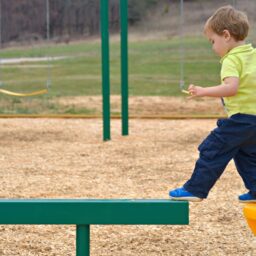
For some kids it comes naturally. Hopping on one foot, jumping rope and walking along a wall is second nature. For others it takes a little practice. But having good balance can be learned! It’s a function that can be improved with practice and is a skill worth having. Teaching your child good balance at an early age will set her up for better body awareness, coordination, and even concentration.
Physical balance is the foundation on which many other physical skills are built. Because kids are spending more time bent over computers and shouldering heavy backpacks, experts believe that their balance is becoming more challenged. Continuously hunching over a screen or carrying extra weight can affect posture and balance, which could lead to less coordination or even problems with gait.
The solution is … well … fun. Common games like hopscotch and tag promote balance. And kid-appropriate activities in yoga and Pilates can also help. There are also simple exercises families can do at home to boost stability.
Researchers are connecting balance to mental, not just physical, functioning. When kids stabilize themselves from an unstable pose, they learn how to focus faster and more efficiently. Kids with learning problems, who often have less than optimal balance, can particularly benefit from balance training. If you free up the mental capacity they are using to concentrate on balance, they have the mental resources to focus on other things.
Balance-Building Exercises for Children
Under One Year: Once your baby begins to sit up, let her grab your fingers and pull herself into a sitting position. Slowly move your hands toward her, just enough so that she begins to rely on her own sense of balance. If she begins to teeter, gently support her back into an upright position. Repeat as long as it is fun for her.
One to Three Years:
Boot Balancers: Sit in a chair and have your child stand in front of you with his arms extended from his sides. Reach your hands underneath his arms (but don’t support his weight) so you can catch him if he loses his balance, and have him step up onto the tops of your shoes. Make a game of how long he can balance himself on your feet.
Stork Stands: Together with your child, stand straight with your feet shoulder-width apart, hands on hips. Stand on your left leg, bending the right leg slightly behind you. Hold this pose for two seconds, then slowly extend your right leg straight out and slightly in front of you without touching the ground. Hold for two seconds and repeat the exercise standing on the right leg, resting your opposite foot on your supporting leg if you need to rest. Once this feels easy, try extending your arms out in front of you or overhead. Playing Simon Says with your child, alternating as leader, can make this drill even more fun.
Three Years and Up:
Balance Beam Lunges: Have your child stand on a long board (a 2-by-4 is fine). She should place her left foot several feet forward on the beam and lunge down until her left thigh is parallel to the ground (her right knee will bend as she deepens the pose). After she holds this position as long as she can, have her repeat the move with the other leg. With practice, your child can lunge with her arms extended out from her sides. For a challenge, raise the board six inches by placing wood or cinder blocks under both ends.
Wheelbarrows: Have your child stand behind a basketball or large ball that will support her body weight and then place her hands, fingers pointing forward, on it. Keeping her feet planted, she should roll the ball forward, alternating hands. Once she rolls it as far from her feet as she can without losing balance, she should roll it back to its original position. Repeat as many times as she’s able.
From Parenting Magazine